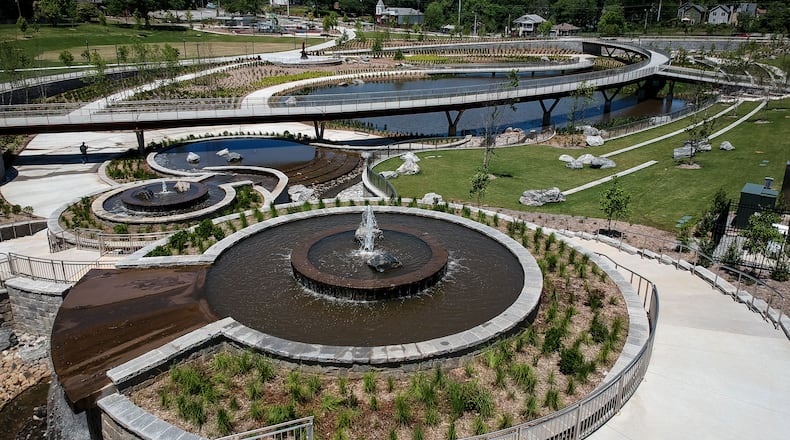The soon-to-open Rodney Cook Sr. Park in Vine City covers only 16 acres, but its backers believe it could revitalize an entire neighborhood.
Situated in an area of Atlanta’s Westside prone to severe flooding, the park’s main purpose is to control stormwater.
But the park has more lofty ambitions, too, its supporters say. Those include creating a safe space for neighborhood residents to spend time outdoors and providing an amenity to a neighborhood that’s long suffered from crime, poverty and lead contaminated soil.
“People can’t wait for it to open,” said Robert Orr, a neighborhood resident.
The $40 million park, a half-mile west of Northside Drive and in sight of Mercedes-Benz Stadium, is scheduled to open in June, though the exact date hasn’t been announced.
The city and the Trust for Public Land designed a series of water fountains and a linear pond as the park’s major visual features. Monuments, statues and plaques that commemorate the city’s civil rights leaders will occupy a prominent place in the park’s center. The Rev. Martin Luther King Jr. once lived with his family in a nearby home.
Credit: HDR
Credit: HDR
But for all the potential good the park can provide, it doesn’t come without controversy. The park, in a decidedly Black neighborhood, is named after Rodney Mims Cook Sr., a white alderman and state legislator who pushed for civil rights in the 1960s.
From city hall to the streets of Vine City, heated discussions revolving around race, history and power have, at times, overshadowed the park. Many Black residents, as well as power brokers like former Mayor Andrew Young, backed naming the neighborhood’s new centerpiece after Cook, pointing to the good work he had done to promote equality.
Others strongly objected, saying it should be named after a Black leader or no one.
City officials hope the park will attract private development to the area, said John H. Lewis, chairman of the Vine City Civic Association. The community is eager for the new residential and commercial development that the park will bring, but not the traffic that tends to come with it.
“Anybody in the city can come use the park, but we don’t want it to be overcrowded with tourists,” Lewis said.
An increase in traffic is almost certainly on its way, even if it’s limited to cyclists and walkers. A bike path along Joseph E. Boone Boulevard provides direct access to the Beltline, the walking and cycling trail that circles the city.
Credit: Steve Schaefer
Credit: Steve Schaefer
But blight is a problem for the neighborhood, said Jay Wozniak, director of urban parks for the Georgia chapter of the Trust for Public Land. A vacant apartment building sits directly across Elm Street from the park’s playground.
James Arpad, who owns the vacant apartment building, said he rehabs blighted properties for both market-rate and affordable housing. Arpad said he wants the park to stimulate the development of more affordable housing.
“The neighborhood struggled for so long with flooding, and contamination was rampant,” he said. “Now it seems like we’re in the right place at the right time.”
The integrated stormwater management system at Rodney Cook Sr. Park is expected to capture about 37 million gallons of stormwater per year from the surrounding neighborhood.
Safety was also a key concern, Wozniak said. Landscape architects designed the park so visitors can almost see the entire property from any vantage point. That creates a sense of safety.
Designers created the clear lines of sight by grading the property to be roughly the same shape as a saucer. Trees were planted in a way to not block views.
It’s a difficult balancing act to add a large park to a neighborhood without causing a certain level of gentrification, said George Dusenbury, southern hub director for the Trust for Public Land.
“You can’t design a park to prevent displacement” of residents, Dusenbury said. “But you can engage the community to devise a plan to address displacement.”
Home prices in Vine City already have been rising. The average price of a single-family home in Vine City has risen from $13,738 in 2011 to $255,261 this year, according to Adams Realtors. The average price of a home in other intown neighborhoods rose from $307,009 to $580,933 in the same period.
Nonprofits and homebuilders that specialize in affordable units are trying to snap up as many lots in Vine City as possible, said John Ahmann, CEO of the Westside Future Fund. But private developers that want to build luxury housing are very aggressive.
“Getting hold of property to develop affordability is becoming extremely difficult,” Ahmann said.
Displacement is a challenging problem, but the park’s goal of “rectifying some of the past environmental injustice” that’s taken place in Vine City is within reach, Ahmann said.
The Environmental Protection Agency has found high lead levels in the soil in the Vine City and English Avenue. The contamination is a byproduct of the neighborhood’s industrial past and decades of exhaust fumes from leaded gasoline.
Neighbors stressed that they wanted the park to be designed to host large outdoor events, like Piedmont Park’s Dogwood Festival, Dusenbury said. The design includes paved pathways wide enough to install exhibition tents.
Designers nixed the community’s request for a swimming pool due to safety and maintenance concerns, Wozniak said. Instead, the park features a splash pad.
Even without a pool, the park already has attracted children and their parents.
On a recent morning, two teenage girls, Kyara Ainsley and Niya Smith, entered the not-yet-opened park through a gap in the fencing and walked through while listening to music on earbuds. Smith said they probably will pass through the park frequently since they live close by.
“You already see a lot of kids out here and a lot of people walking their dogs,” Smith said. “Yeah, it will be nice.”
Staff writer Ernie Suggs contributed to this report.
About the Author
Keep Reading
The Latest
Featured




